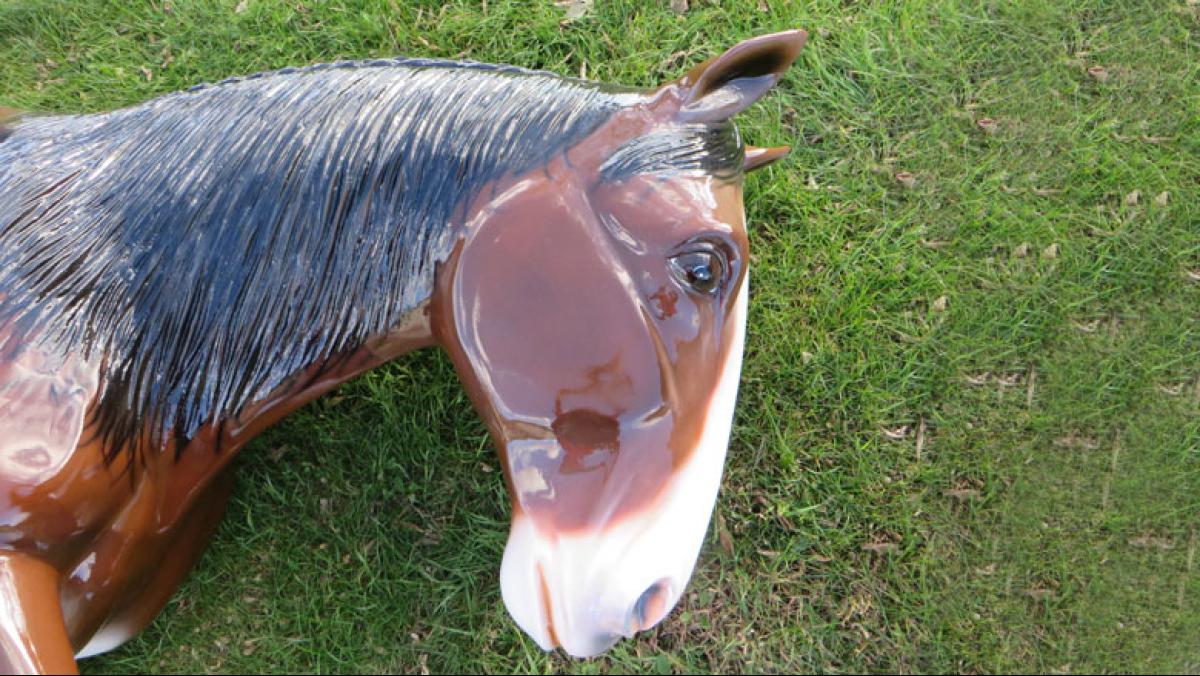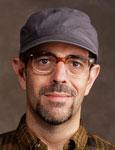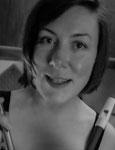It’s a crisp autumn day in the small town of Sparta, Wisconsin, and Darren Schauf is showing off the tools of his trade: around six hundred very large fiberglass molds strewn across a five-acre field. Most of the fiberglass molds are oversized versions of recognizable shapes—a horse here, a beer bottle there, assorted arms, legs, and faces all over the place. The molds are primarily a drab yellowish brown, and most are lying on their sides, making them look discarded or dead, almost like a post-war battle field from another time. Or planet.
But where some might see a big field of junk, Schauf sees the lifeblood of his business. “This is our agriculture section,” he says proudly, walking past a pile of fiberglass carapaces. “Pigs, horses, cows. There’s Babe the Blue Ox, who goes with Paul Bunyan. Oh, look, you’re standing on Paul Bunyan’s ax!” he says, pointing down at a brown mold surrounded by long, green grass.

We’re strolling the grounds of FAST Corporation (the acronym stands for Fiberglass Animals, Shapes, and Trademarks), one of the country’s most intriguing and entertaining niche manufacturers. Schauf, the company’s general manager, and his crew use these molds to cast the large fiberglass statues that have become icons of roadside Americana. If you’ve ever seen a big steer perched atop a steakhouse, a giant soft-serve cone in front of an ice cream stand, or a Bob’s Big Boy statue, FAST probably made it.
FAST’s fiberglass sculptures are designed to withstand decades of weather and rigorous use with very little maintenance. So, it makes sense that the company also manufactures slides for water parks, a specialty branch that constitutes a surprising 40% of FAST’s overall business. Even more interesting is the occasional collaboration with an artist who needs a specialized manufacturer like FAST to execute a large-scale project.
Take for instance the thirty-foot eyeball FAST made for Chicago sculptor Tony Tasset in 2007. Working from a photograph of his own eye and in consultation with FAST designers, Tasset created the three-story sculpture with the intent of making “art that speaks to the biggest audience possible.” Commissioned by the Chicago Loop Alliance for the 2010 Art Loop installation, Tasset’s three-story Eye currently resides in Laumeier Sculpture Park in St. Louis, Missouri.
FAST, which has two-dozen employees, produces close to 1,000 statues a year and typically has about fifty pieces in various stages of production at any given moment. Turnaround time ranges from six to ten weeks. About 10% of the company’s projects are custom jobs; the rest are stock designs from the FAST Corp. catalog, which is why all those molds are kept out in the field. If someone orders, say, a giant ear of corn, the appropriate mold will be brought in from the field and the piece will be cast in fiberglass. The molds are too big to put in storage, so they just sit there out in the open, which works out fine. It’s not as though anyone’s going to sneak off with a fifteen-foot-tall root beer mug.

We’ve all seen giant statues at some point—the world’s largest this, a colossal that. But what, exactly, is the appeal of the titanic? Part of it, to be sure, is the simple—if quintessentially American—truism that large things are impressive. But there’s something else at work here. It’s one thing to be wowed by a very large mountain; it’s quite another to encounter a very large cow, or banana, or bottle of Tabasco sauce.
Of course we can’t change our own size. But by changing the size of these everyday items we change our relationship to them. There’s something in our brains that finds wonder and delight in this warped sense of scale (in case you haven’t guessed, it works with miniatures, too). This wonder and delight form the core of FAST’s commercial and popular appeal.
But while FAST’s fiberglass sculptures are large and attention-getting, the company itself is one of those enterprises that hover just under the radar. We all understand on an intuitive level that someone is making these giant, iconic pieces. But very few of us have ever thought about who these someones might be.

FAST is the third incarnation of a Sparta-based company that began in the 1960s under the name Sculptured Advertising. A few sculptures from this era are still in use (including a steakhouse steer that was recently returned to FAST for repairs after having been hit by a car). The company then became known as Creative Display at some point in the mid-1970s. In 1983, a designer and artist named Jerry Vettrus took over the operation and renamed it FAST Corporation. Many of the molds out in the field today were designed by Vettrus himself.
By 2000, Vettrus was looking to sell. “Jerry had grown the business to a certain point, but he was an artist,” says Schauf. “He kind of ignored a lot of the aspects of running the business. He was more about sculpture and painting.” Vettrus ended up selling FAST to Schauf’s father, James, a former manufacturing executive. The younger Schauf, who’d been working for a market research firm down in Madison, came on board in 2007 and now runs FAST’s day-to-day operations, a job he clearly enjoys. “It’s a lot more fun to build a twenty-foot dog than to sit at a desk all day and then write a report,” he says.
And with that, he leads the way to a building where a FAST crew is working on, sure enough, a twenty-foot dog—a Dalmatian, to be precise. This is a complicated custom job, because each of the Dalmatian’s spots is actually a window that will be fitted with a light, which necessitated the creation of an internal armature to support the lighting system.
Most FAST products are much simpler than the dog. Assuming the mold for a project doesn’t already exist out in the field, the process begins with the creation of a “plug” or model. Schauf points to one that’s currently being made for a two-scoop ice cream cone. “The only other double-scoop cone we have is the one we use for a chain called Andy’s Frozen Custard,” he explains. “Andy doesn’t technically have an exclusive on that design, but he’s a good customer, so I’m building a new double-scoop cone that we can market to other customers, and I won’t sell Andy’s to anyone else.”
The new ice cream cone plug, like all FAST plugs, is made from expandable urethane foam. “It’s great stuff,” says Schauf. “You spray it on and it expands to, like, ten times its size. Then you cut it with a filet knife. If you cut off too much, you just spray on some more and do it over. We just use a photo for reference until it looks right.”

One challenge when sculpting the plug is to minimize undercuts or recessed areas, which will make the mold harder to remove from the plug. The more undercuts there are, the more pieces the mold will end up being. In the case of the two-scoop cone, Schauf says the resulting mold will probably end up being fifteen to twenty separate pieces.
Once a plug is finished, it’s painted with a releasing agent to make it slick. Then it’s coated with multiple layers of fiberglass to create the mold.
The mold is removed from the plug in several pieces, and the plug discarded (they’re not very recyclable, unfortunately, so they end up in the landfill), leaving behind a perfect negative image in which to cast a new sculpture following the same process used to create the mold.
After the sculpture is cast it is glued together, sanded, and hand painted by FAST artists. The mold joins the others out in the field. “We don’t throw any of them away,” says Schauf. “Even if I think we’ll probably never use it again, we hold onto it.”
The economic downturn of recent years has had surprisingly little effect on FAST, in part because more people have been foregoing lavish vacations in favor of simple road trips or “staycations” (in which families tour local attractions, usually via automobile), two factors that have increased the demand for roadside statuary. FAST has also benefited from the growth of agritourism, where the rising popularity of corn mazes, “pick your own pumpkin” patches, and so on has led to more orders from farmers looking to spruce up their properties with a giant chicken or an eight-foot pumpkin hut.
You’d think other players would want to get in on the action, but FAST appears to have the market largely to itself.
“We’re not a big company, but we’re the biggest in the industry,” says Schauf. “The other people who do what we do, working with fiberglass, are mostly ‘onesie, twosie’ types in a garage. There are lots of companies now doing 3-D CAD [computer aided design] cutting of EPS [expanded polystyrene] foam, which they’ll hard-coat with sprayed plastic. It looks really nice, but it’s extremely expensive for large pieces, so they can’t really compete with us for the big stuff.”

“Big stuff,” of course, is a relative notion. Up until now, FAST’s magnum opus has been the 143-foot walk-through muskie that forms the centerpiece of the Freshwater Fishing Hall of Fame & Museum, located about three hours north of Sparta in Hayward, Wisconsin. But the company recently began work on a project more than twice as large as the muskie: a 300-foot-wide eagle that will crown the Red Lake Indian Nation’s new capitol building in northern Minnesota.
“The wings will be attached to the building, and the head will be fully three-dimensional and will blend into the breastplate underneath it,” says Schauf, not without a touch of pride.
And when the eagle is done, the mold for it will presumably take its place out behind the fabrication building along with all the others. Although the distribution of the molds in the field may seem random, there’s actually a bit of a system.“I don’t like to think of it as our cemetery or graveyard,” says Schauf. “It’s our mold warehouse.” Then he adds, “Some people also call it the Sparta Zoo. … We have fish in one area, African animals in another, and so on.”
Indeed, the Sparta Zoo has become something of a tourist draw over the years, with curious visitors stopping by for a photo op with Paul Bunyan or Big Boy. The company doesn’t promote this type of thing, but doesn’t discourage it either; and guests are generally welcome to roam around as long as they don’t climb on the molds.
As small groups of people wander through this fiberglass menagerie, looking diminutive against the giant animals and oversized icons, I consider the full-circle element to FAST: Here’s a small company known for creating roadside attractions that has itself become a roadside attraction, an American cultural touch point that continually renews itself by creating more and more Americana.
This surreal loop of self-reference isn’t lost on Schauf. “I’ve definitely thought about that,” he says, strolling past a giant hamburger mold. “And there’s something very satisfying about it.”
Editor's Note: A version of this essay originally appears in re:form, a publication of Medium.com





